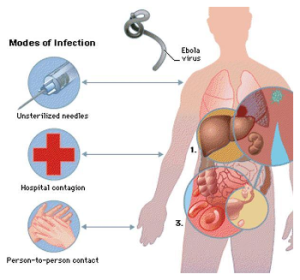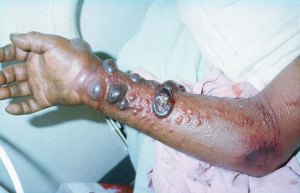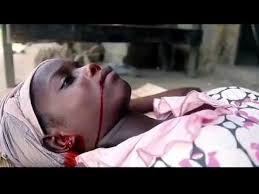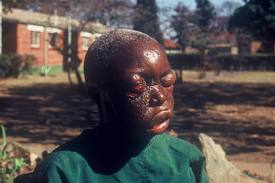EBOLA VIRUS
Ebola virus is a life threatening virus which is responsible for causation of hemorrhagic fever among the human and primates. Internal or external bleeding can result after getting infection from Ebola virus. It appertains to the genus Ebolavirus of Filoviridae family and order Mononegavirales.
The Zaire Ebola virus species are also the type species (reference or example species) for Ebola virus. In 1976, first case of Ebola virus was identified near the Ebola River valley in Democratic Republic of the Congo (Zaire). This virus was named after the Ebola River. Another outbreak of Ebola virus occurred in the same year, in southern Sudan with 151 deaths. The vector or the host carrying Ebola virus is still a mystery which has leaded to unavailability of vaccination or other treatment against this virus. However some researchers consider Fruit bats belonging to Pteropodidae family as the natural host of the Ebola virus. Incomplete knowledge about Ebola virus is a justification for lack of Eradication programs. Rapid transmission of viral reservoirs to human populations further aggravates the severity. As this is an endemic of remote areas, sampling difficulties has made the study of this disease complicated; pathogenesis of the disease is obscured.
DIAGNOSIS AND LABORATORY FINDINGS
The diagnosis of Ebola virus can be accomplished by the given tests;
• Enzyme-linked Immunosorbent assay (ELISA)
• Electron microscopy
• Antigen detection tests.
• Reverse Transcriptase Polymerase Chain Reaction assay (RT-PCR)
• Serum neutralization test.
• Virus isolation by tissue culture technique.
Laboratory and clinical studies require large Bio hazard containment as Ebola is a highly contagious virus. Laboratory findings of the Ebola infection decipher low white blood cell and platelet counts. Elevation of liver enzymes is another pathological sign.
TRANSMISSION OF EBOLA VIRUS
Infection of Ebola virus is spread through a close contact with the blood and other body fluids of the infected animals. Having a direct contact with the secretions of the mucous membranes or damaged skin, blood of the infected individuals, contaminated environment and handling of infected animals such as, fruit bats and monkeys has been found as a major cause for the endemic. This virus is so contagious that it can spread from the infected dead person to the mourners during burying ceremony. Even the recovered patients can discharge the virus in their semen for up to 7 weeks.
SYMPTOMS OF THE INFECTION
The initial symptoms of this acute viral infection are headache, muscle and joint pain, intensive weakness or tiredness, fever and pain in the throat. Liver and kidney dysfunction, bloody vomiting are symptoms which appear on later stage of the infection. Finally the condition of patient worsens due to both internal and external bleeding. Ebola virus has an incubation period of 2 to 21 days.
TREATMENT FOR EBOLA VIRUS
At present, there is a lack of approved Medicine or vaccine to conquer Ebola virus. A number of experimental treatments are under the clinical studies. Supportive therapy including use of rehydrating fluids, electrolytes and anti-coagulants during early phase of infection is the only treatment. Early treatment may enhance the survival.
PREVENTIVE MEASURES
• It is wise to avoid visiting the endemic regions such as Africa, make sure about the current status of epidemic by getting information from the website of the Centers for Disease Control and Prevention.
• Practice the hygienic habits by repeated sanitation or washing of hands.
• Make an avoidance to get closer to the infected people and don’t consume wild animal’s flesh.
• Infected Person or animal should be confined to a place which is away from the reach of non-infected individual. Proper Disposal and sterilization of needles and other instruments is a must.
• Dead bodies of infected patients can also transmit infection. So, special precautionary measures must be employed by mourners.








